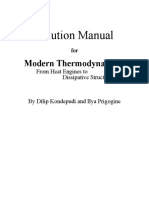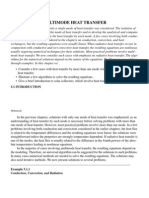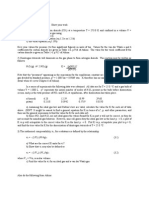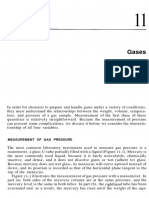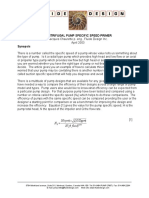HWCHPT 1
HWCHPT 1
Uploaded by
Rodrigo GonzalezCopyright:
Available Formats
HWCHPT 1
HWCHPT 1
Uploaded by
Rodrigo GonzalezOriginal Title
Copyright
Available Formats
Share this document
Did you find this document useful?
Is this content inappropriate?
Copyright:
Available Formats
HWCHPT 1
HWCHPT 1
Uploaded by
Rodrigo GonzalezCopyright:
Available Formats
Solution Manual
for
Modern Thermodynamics:
From Heat Engines to Dissipative
Structures
By Dilip Kondepudi and Ilya Prigogine
Solutions Manual/Kondepudi & Prigogine Chapter 1 1
Solutions to Exercises: Chapter 1
1.1 Consider two identical vessels, one containing CO
2
(g) and the other He(g). Assume
that both contain the same number of molecules and are maintained at the same
temperatures. The pressure exerted by a gas is a result of molecular collisions against the
container walls. Thus, intuitively one might expect that the pressure exerted by the heavier
molecules of CO
2
(g) will be larger than the pressure due to He(g). Compare this
expectation with the pressure predicted by the ideal gas law (or the Avogadro hypothesis).
How would you explain the prediction of the ideal gas law -- which is validated by the
experiment ?
Answer: The pressure exerted by a gas depends on both the mass and the average
speed of the molecules.
At a given temperature, the heavier molecules travel slowly in such a way that the pressures
of two gases are equal if (N/V) is the same. The average kinetic energy of a gas molecule
at a temperature T is given by (m/2)v
2
avg
= (3/2)kT, in which m is the mass of a single
molecule v
avg
is the average speed and k =1.38x10
-23
JK
-1
, is the Boltzmann constant.
Since N
A
k = R we can also write (M/2)v
2
avg
= (3/2)RT in which M is the molar mass of
the gas. This relation shows that, at a given temperature the average speed of molecules of a
gas is lower for heavier molecule, but the average kinetic energy is the same
-----------------------------------------------------------------------------------------------------------
1.2 Describe an experimental method, based on the ideal gas law, to obtain the molecular
mass of a gas.
Answer: By measuring p, V and T of a gas, its mole number can be determined
because N=(pV/RT). If a flask of volume V is filled with the given gas of mass m, and if
the p and T are its pressure and temperature respectively, then the molar mass of the gas
M =
m
N
=
mRT
pV
----------------------------------------------------------------------------------------------------------
Solutions Manual/Kondepudi & Prigogine Chapter 1 2
1.3 (a) Calculate the number of moles of gas per m
3
of atmosphere at p=1 atm and T=298
K using the ideal gas equation.
(b) The atmospheric content of CO
2
is about 360 ppmv (parts per million by volume).
Assuming a pressure of 1.00 atm, estimate the amount of CO
2
in 10.0 km layer of the
atmosphere at the surface of the Earth. The radius of the Earth is 6370 km. ( The total
amount of CO
2
in the atmosphere is about 6.0x10
16
moles).
(c) The atmospheric content of O
2
is 20.946 % by volume. Using the result in part (b),
estimate the total amount of O
2
in the atmosphere.
(d) Life on Earth consumes about 0.47x10
16
moles of O
2
per year. If the photosynthetic
production of O
2
were to suddenly stop, how long will the oxygen in the atmosphere last at
the present rate of consumption ?
Answers:
(a) Since 1.0 m
3
= 10
3
L, the number of moles of gas in 1.0 m
3
is:
N =
pV
RT
=
1.0atm x 10
3
L
0.0820L.atm.K
1
. mol
1
x298
= 40.9mol
(b) At a given temperature and pressure, the number of moles is proportional to the
volume. Since the CO
2
is 360 ppm by volume, the number of moles of CO
2
per m
3
is:
N
CO2
= 40.9 x 360 x10
-6
= 0.0147 moles/m
3
If R
E
= 6370x10
3
m is the radius of the earth, the "volume" of the atmosphere in a layer of
height h can be approximated by:
4R
2
E
h = 4x3.141x( 6370x10
3
m)
2
(10x10
3
m) = 5.098 x 10
18
m
3
.
(the exact volume is (4/3)[(6380x10
3
)
3
(6370x10
3
)
3
]=5.1061x10
18
)
Number of moles of CO
2
in this layer = 0.0147 moles/m
3
x 5.1 x 10
18
m
3
= 7.4 x 10
16
moles.
( this estimate is larger than the actual value of 6.0x 10
16
moles because the pressure
decrease with height ).
Solutions Manual/Kondepudi & Prigogine Chapter 1 3
(c) 360 ppm = 3.6x10
-4
= 3.6x10
-2
%. Since 20.9 % of the atmosphere is O
2
, the amount
of O
2
in the 10 km layer =
20.9
3.6x10
2
x7. 4x10
16
= 4.3x10
19
mol .
(d) Sine the consumption of O
2
by life on the planet is approximately 0.47x10
16
mol/year
the oxygen should last about :
4.3x10
19
mol
0. 47x10
16
mol / year
= 9100 years!
---------------------------------------------------------------------------------------------------------
1.4 The production of fertilizers begins with the Haber processes which is the reaction
3H
2
+ N
2
-----> 2NH
3
conducted at about 500 K and a pressure of about 300 atm.
Assume that this reaction occurs in a vessel of fixed volume and temperature. If the initial
pressure due to 300.0 mol H
2
and 100.0 mol N
2
is 300.0 atm, what will the final pressure
be ? What will the final pressure be if initially the system contained 240.0 mol H
2
and
160.0 mol N
2
?
Answers:
Initially there are 400 mol of gas at T=500K and p=300atm. After the reaction,
there are only 200.0 moles of NH
3
. Since N decreased by a factor of 2, for the same V and
T, the pressure will also decrease by a factor of 2, i.e. p=150 atm.
If initially there are 240.0 mol H
2
and 160 mol N
2
, 80 mol of N
2
will react with the
H
2
and produce 160 mol NH
3
and 80 mol of N
2
will remain. Hence the total number of
moles in the volume is 240 mol. Thus the number of moles has decreased by a factor
(240/400)=3/5. Hence the presser will also decrease by a factor of 3/5, i.e. the final
pressure will be (3/5)300.0atm = 180.0 atm
------------------------------------------------------------------------------------
1.5 The van der Waals constants for N
2
are: a= 1.390 L
2
.atm.mol
-2
b= 0.0391 L.mol
-1
. Consider 0.5 moles of N
2
(g) is in a vessel of volume 10.0L.
Assuming that the temperature is 300 K, compare the pressures predicted by the ideal gas
equation and the van der Waals equation.
Solutions Manual/Kondepudi & Prigogine Chapter 1 4
(a) What is the percent error in using the ideal gas equation instead of van der Waals
equation?
(b) Keeping V= 10.0L, use Maple/Mathematica to plot p vs N for N = 1 to 100, using the
ideal gas and van der Waals equations. What do you notice regarding the difference
between the pressure predicted by the two equations ?
Answers:
(a) The pressure predicted by ideal gas equation:
p=NRT/V = 1.231 atm.
The pressure predicted by van der Waals equation:
p =
NRT
V Nb ( )
a
N
2
V
2
= 1.230 atm
The percent error =
1.2311.230
1.230
100 = 0.08%
Mathematica Code
==================================================
In[5]:=
(* Exc. 1.5(b)*)
Clear[a,b,R,T];
a=1.390; b=0.039;R=0.0821; T=300;
vwp[N_]:=(N*R*T/(10.0-b*N))-(a*(N/10.0)^2)
idp[N_]:=N*R*T/10.0
In[8]:=
Plot[{vwp[N],idp[N]},{N,1,100}]
Solutions Manual/Kondepudi & Prigogine Chapter 1 5
=====================================================
Maple Code
============================================================
#Exc 1.5 (b);
restart;
VWP:= N->(0.082*300*N/(10.0-0.0391*N))-1.390*(N/10.0)^2;
N 2
VWP := N -> 24.600 ---------------- - .01390000000 N
10.0 - .0391 N
> IDP:= N->0.082*300*N/10.0;
IDP := N -> 2.460000000 N
> plot([VWP(N),IDP(N)],N=1..100);
--------------------------------------------------------------------------------------
1.6 For 1.00 mol of Cl
2
in a volume of 2.50 L, calculate the difference in the energy
between U
ideal
and U
vw
. At T=298K what is the % difference when compared to
U
ideal
=(5/2)NRT ?
From equation (1.3.11) it follows that:
U
ideal
- U
vw
= a(N
2
/V) = 6.51L
2
.atm. mol
2
1. 00mol
2
2.50L
=2.60atm.L
Note: 1.0 atm.L = (101.3x10
3
Pa) x (10
-3
m
3
) = 101.3 J
Solutions Manual/Kondepudi & Prigogine Chapter 1 6
Hence: 2.60 atm.L. = 263 J
U
ideal
= (5/2)RT = (5/2) (8.314 JK
-1
)(298K) = 6.19 kJ
U
ideal
U
vw
U
ideal
x100 =
263J
6.19x10
3
J
x100 = 4.2%
--------------------------------------------------------------------------------------
1.7 (a) Using the ideal gas equation calculate the volume of one mole of a gas at
temperature of 25C and pressure of 1 atm. This volume is called the Avogadro volume.
(b) The atmosphere of Venus is mostly CO
2
(g). The surface temperature is about 750K
and the pressure is about 90 atm. Using the ideal gas equation calculate the volume of one
mole of CO
2
(g) under these conditions (Avogadro volume on Venus).
(c) Use Maple/Mathematica and van der Waals equation to obtain the Avogadro volume on
Venus and compare it (find the % difference) with the result obtained using the ideal gas
equation.
Answers:
(a) V
avgd
= RT/P = R*T =( 1.00 mol) (0.0821 atm.L.mol
-1
.K
-1
) 298K/1.00atm
= 24.5L
(b) On Venus, V
avgd
= ( 1.00 mol) (0.0821 atm.L.mol
-1
.K
-1
) 750K/(90.0atm)
= 0.684 L
(c) Mathematica Code
====================================================
In[3]:=
(*Exc. 1.7(c)*)
Clear[a,b,R,T];
a=3.59; b=0.0427;R=0.0821; T=750;
eq:=(1.0*R*T/(V-1.0*b))-a*(1/V^2)-90
Solve[eq==0,V]
Out[4]=
{{V -> 0.0278235 - 0.0419929 I}, {V -> 0.0278235 + 0.0419929 I}, {V -> 0.67122}}
The real solution is V = 0.671. Hence this is the Avogadro volume on Venus.
===========================================================
Solutions Manual/Kondepudi & Prigogine Chapter 1 7
Maple Code:
===========================================================
> #Exc 1.7(c);
> restart;R:=0.0821;T:=750;a:=3.59;b:=0.0427;
> eq:=(1.0*R*T/(V-1.0*b))-a*((1.0/V)^2)=90;
> solve(eq,V);
R := .0821
T := 750
a := 3.59
b := .0427
61.57500 3.5900
eq := ---------- - ------ = 90
V - .04270 2
V
.02782347980 - .04199293909 I, .02782347980 + .04199293909 I,
.6712197071
Since the above equation is a third degree equation, there are 3 roots, two of them being
complex. The real root V=0.671 is the Avogadro volume on Venus.
======================================================
1.8 The van der Waals parameter b is a measure of the volume excluded due to the finite
size of the molecules. Estimate the size of a single molecule from the data in Table 1.1.
Answer: A crude estimate of the size of the molecule can be obtained by assuming that it is
spherical and by equating b to the total volume of N
A
molecules. For CO
2
, for example this
gives:
4
3
r
3
N
A
= 0.0427x10
3
m
3
. mol
1
This gives a radius r = 2.5x10
-10
m.
Solutions Manual/Kondepudi & Prigogine Chapter 1 8
A better estimate is obtained by identifying the "excluded volume" by the finite size of the
molecules. As shown in figure bellow, in a gas, each pair of molecules "excludes" a
volume equal to
4
3
2r ( )
3
. Hence the total reduction in the available volume is
4
3
2r ( )
3
1
2
N
A
= 3.59x10
3
m
3
. mol
1
.
This gives a radius r=1.6x10
-10
m.
1.9 Though van der Waals equation was a big improvement over the ideal gas equation, its
validity is also limited. Compare following experimental data with the predictions of the van
der Waals equation for one mole of CO
2
at T= 40C. (Data source [C] )
p/ atm V
m
/L.mol
-1
1 25.574
10 2.4490
25 0.9000
50 0.3800
80 0.1187
100 0.0693
200 0.0525
500 0.0440
1000 0.0400
1.10 Use Mathematica/Maple to plot the van der Waals p-V curves for some of the gases
listed in Table 1.1. (See Mathematica/Maple appendix for sample programs). In particular,
compare the van der Waals curves for CO
2
and He and the ideal gas equation.
Solutions Manual/Kondepudi & Prigogine Chapter 1 9
Answer:
Maple Code.
=========================================================
> # Exc 1.10 Maple code for plotting van der Waals curves for CO2;
> restart;
> VWCO2:= (V,T)->(0.0821*T*1.0/(V-0.0427))-3.59*(1.0/(V^2));
> ID:=V->0.082*310/V;
> VWHe:= V->(0.082*310*1.0/(V-0.0237))-0.034*(1.0/V^2);
> plot([VWCO2(V,310),ID(V),VWHe(V)],V=0.05..0.3, thickness=2);
======================================================
1.11 From the van der Waals equation, using (1.4.2) obtain (1.4.3) and (1.4.4). (These
calculations may also be done using Mathematica/Maple) (see appendix 1.2 Code B)
For the van der Waals equation (N=1):
p =
RT
(V b)
a
V
2
At the critical point:
Solutions Manual/Kondepudi & Prigogine Chapter 1 10
p
V
T
=
RT
c
V
mc
b ( )
2
+
2a
V
mc
3
= 0 (1.11.1)
2
p
V
2
T
=
2RT
c
V
mc
b ( )
3
6a
V
mc
4
= 0 (1.11.2)
Solving these two equations for V
mc
and T
c
we find:
V
mc
=3b and T
c
=8a/27Rb
Substituting these values in the vander Waals equation we get:
p
c
= a/27b
2
.
From these equations, (1.4.3) and (1.4.4) follow.
1.12 Using Table 1.1 and the realtions (1.4.4) obtain the critical temperature T
c
, critical
pressure p
c
and critical molar volume V
mc
for CO
2
, H
2
and CH
4
. Write a
Maple/Mathematica code to calculate the van der Waals constants a and b given T
c
, p
c
and
V
mc
for any gas.
Gas T
c
/K p
c
/atm V
mc
/L
CO
2
303.4 72.9 0.128
H
2
33.1 12.7 0.0798
CH
4
189.7 45.5 0.128
Mathematica Code
=========================================================
Clear[a,b]
a=3.59;b=0.0427;R=0.0821;
T=8*a/(27*R*b)
p=a/(27*b^2)
v=3*b
=========================================================
Solutions Manual/Kondepudi & Prigogine Chapter 1 11
Maple Code
==========================================================
restart;
> a:=3.59;b:=0.0427;R:=0.0821;
> T=8*a/(27*R*b);
> p=a/(27*b^2);
> v=3*b;
==========================================================
1.13 Using Mathematica/Maple obtain the equation (1.4.6) from (1.4.5).
The Mathematica code is in Appendix 1.2, Code C.
Maple Code
==========================================================
> #Exc 1.13
> restart;
> p:=(T,V)->(R*T/(V-b))-(a/V^2);
> T:=(Tr*8*a)/(27*b*R); V:=Vr*3*b;pc:=a/(27*b^2);
> eq:=p(T,V)/pc;
> eq1:=simplify(eq);
> convert(eq1,parfrac,Vr);
Tr 3
8 -------- - ---
3 Vr - 1 2
Vr
===========================================================
You might also like
- Solution Manual: Modern ThermodynamicsDocument12 pagesSolution Manual: Modern ThermodynamicsMuhammed Fuad0% (2)
- Design and Calculation Methods For Uniflow Cyclones Mar19 - SP PDFDocument11 pagesDesign and Calculation Methods For Uniflow Cyclones Mar19 - SP PDFSteve Wan100% (1)
- Multi ModeDocument73 pagesMulti ModeShalinee KavadiyaNo ratings yet
- ThermalPhysics 1 SolnsDocument24 pagesThermalPhysics 1 Solnsrbebeau100% (2)
- Shell and Tube Heat Exchangers FormulaDocument3 pagesShell and Tube Heat Exchangers FormulayuvionfireNo ratings yet
- Ideal Gas Law ProblemsDocument4 pagesIdeal Gas Law ProblemsJopie Aranda0% (1)
- Swirl AngleDocument3 pagesSwirl AngleNIGERE100% (6)
- Homework Problem Set 2 SolutionsDocument12 pagesHomework Problem Set 2 SolutionsMuzamil Shah100% (1)
- Phychem AssignmentDocument37 pagesPhychem Assignmentmunding21100% (5)
- Bab 1 SolutionsDocument37 pagesBab 1 SolutionsDeni MustikaNo ratings yet
- 2012 Gaseous State Tutorial TeacherDocument10 pages2012 Gaseous State Tutorial Teacherjzhong_7No ratings yet
- Chm3410hwk01-Soln 249211458Document7 pagesChm3410hwk01-Soln 249211458Jerika ArceoNo ratings yet
- Gases Tutorial 2Document4 pagesGases Tutorial 2Idil WarsameNo ratings yet
- Solution Part 2 (2023)Document9 pagesSolution Part 2 (2023)01khanh26No ratings yet
- Physical ChemistryDocument5 pagesPhysical ChemistryLynnden CastilloNo ratings yet
- 01 1stlaw ExessolsDocument29 pages01 1stlaw Exessolsblanca.pegueraNo ratings yet
- ESE Final SolutionDocument8 pagesESE Final SolutionMomina ShakeelNo ratings yet
- PC2 TP TD HintsDocument13 pagesPC2 TP TD Hintsbaggie.baggie.bagsNo ratings yet
- Chap3 4Document10 pagesChap3 4rpb109100% (1)
- km244 Midterm1 2023Document7 pageskm244 Midterm1 2023Nastech ProductionNo ratings yet
- Chemistry 231 Tutorial Session # 5: The Following Questions Will Be Answered On The Tutorial SessionDocument8 pagesChemistry 231 Tutorial Session # 5: The Following Questions Will Be Answered On The Tutorial SessionFiqkyAkbarNo ratings yet
- A2 53b GasesDocument50 pagesA2 53b GasesHany ElGezawyNo ratings yet
- Chapter 2Document5 pagesChapter 2Marco LuigiNo ratings yet
- MIT16 50S12 Lec6Document8 pagesMIT16 50S12 Lec6Jamal AlshaweshNo ratings yet
- Solved Problems Chapter 2Document13 pagesSolved Problems Chapter 2Ali FarhatNo ratings yet
- Gaseous StateDocument8 pagesGaseous StateGadde Gopala KrishnaNo ratings yet
- Problems303 7 SolDocument3 pagesProblems303 7 Soleloco_2200No ratings yet
- Tutorials For ChemicalthermodynamicsDocument20 pagesTutorials For Chemicalthermodynamicselisee tsokezoNo ratings yet
- 11 GasesDocument17 pages11 Gasespuja ritongaNo ratings yet
- Chemistry 1 Thermodynamics Final and SolutionsDocument11 pagesChemistry 1 Thermodynamics Final and SolutionsFair PisuttisarunNo ratings yet
- Solutions To Exercises: Chapter 10: 10.1 Use The Chemical Potential of An Ideal Gas in (10.1.9) and Obtain The BarometricDocument6 pagesSolutions To Exercises: Chapter 10: 10.1 Use The Chemical Potential of An Ideal Gas in (10.1.9) and Obtain The BarometricSalomé TorresNo ratings yet
- 2 Prediction of Diffusivities PDFDocument26 pages2 Prediction of Diffusivities PDFYee LingNo ratings yet
- Chapter 1 SolnDocument5 pagesChapter 1 SolncupofsaltNo ratings yet
- Gases (Chapter 5) : (1.00 Mol) (0.08206 Mol K L Atm) (273 K) 22.414 LDocument11 pagesGases (Chapter 5) : (1.00 Mol) (0.08206 Mol K L Atm) (273 K) 22.414 LHemant KumarNo ratings yet
- ProblemsDocument6 pagesProblemsdapias09No ratings yet
- Problems 2 1st Law PDFDocument10 pagesProblems 2 1st Law PDFKrystel Monica Manalo0% (1)
- Chap 01Document20 pagesChap 01Jay JayNo ratings yet
- HW5 SolDocument11 pagesHW5 Solondutz33% (3)
- Part FN Worked Examples PDFDocument5 pagesPart FN Worked Examples PDFtizazu dfeteneNo ratings yet
- Lecture 15. The Van Der Waals Gas (Ch. 5) : Nobel 1910Document22 pagesLecture 15. The Van Der Waals Gas (Ch. 5) : Nobel 1910Ihab El SawiNo ratings yet
- Tugas Bab 2Document6 pagesTugas Bab 2Wibowo Unggul0% (1)
- Fluid Mechanics White 7th SOL Part1 Part9Document5 pagesFluid Mechanics White 7th SOL Part1 Part9Jose EscobarNo ratings yet
- Chemistry Question BankDocument55 pagesChemistry Question BankPadma PriyaNo ratings yet
- RT PV: Chem151 (Kua)Document8 pagesRT PV: Chem151 (Kua)Pink PigNo ratings yet
- BT Hoa Ly 1Document22 pagesBT Hoa Ly 1Minh ThưNo ratings yet
- Heat Transfer HWDocument12 pagesHeat Transfer HWrobert kasperNo ratings yet
- 2-1 Speed of Sound:: &T Respectively. As ADocument12 pages2-1 Speed of Sound:: &T Respectively. As Aعبدالله عمرNo ratings yet
- Example CH 6Document8 pagesExample CH 6Cara BakerNo ratings yet
- Computation 2Document17 pagesComputation 2KristineNo ratings yet
- Solution For Plasma PhysicDocument5 pagesSolution For Plasma Physicms_geo100% (6)
- Converting Gas Units: APCH 211 Tut 7 (Review Tut) 2011Document3 pagesConverting Gas Units: APCH 211 Tut 7 (Review Tut) 2011Diego MorenoNo ratings yet
- Assignment MATLABDocument5 pagesAssignment MATLABNanthan DevNo ratings yet
- Aerodynamics ExercicesDocument5 pagesAerodynamics ExercicesMarcRosetNo ratings yet
- Multiple Choice Questions On Mechanics and HeatDocument21 pagesMultiple Choice Questions On Mechanics and HeatGodwinNo ratings yet
- A Modern Course in Statistical PhysicsFrom EverandA Modern Course in Statistical PhysicsRating: 3.5 out of 5 stars3.5/5 (2)
- Analytical Modeling of Solute Transport in Groundwater: Using Models to Understand the Effect of Natural Processes on Contaminant Fate and TransportFrom EverandAnalytical Modeling of Solute Transport in Groundwater: Using Models to Understand the Effect of Natural Processes on Contaminant Fate and TransportNo ratings yet
- Calculation Note For Actuator Air Consumption - Rev 1Document4 pagesCalculation Note For Actuator Air Consumption - Rev 1dadyjoshNo ratings yet
- Chapter: 1 Stoichiometric Relationships: SubtopicsDocument108 pagesChapter: 1 Stoichiometric Relationships: SubtopicsBNo ratings yet
- 1 Darcy Friction CalculatorDocument2 pages1 Darcy Friction CalculatorRraffrizal ChandsNo ratings yet
- API 624 Vs ISO 15848-1Document1 pageAPI 624 Vs ISO 15848-1Ramesh GangwarNo ratings yet
- Btech Me 4 Sem Applied Thermodynamics Kme 401 2023Document2 pagesBtech Me 4 Sem Applied Thermodynamics Kme 401 2023amoghharsh524No ratings yet
- Cryogenic Experts Price Sheet PDFDocument6 pagesCryogenic Experts Price Sheet PDFkanchanabalajiNo ratings yet
- Spare Parts SAB193-233-283S-A-frame 2020.06Document52 pagesSpare Parts SAB193-233-283S-A-frame 2020.06Abdelkader AbdelkaderNo ratings yet
- 2012 Thermal Mass Flow Controller Scaling RelationsDocument13 pages2012 Thermal Mass Flow Controller Scaling Relationsccwang100% (1)
- Chapter Two-Viscous Flow-Part1 PDFDocument11 pagesChapter Two-Viscous Flow-Part1 PDFUNKNOWNNo ratings yet
- Kenr7523kenr7523-03 SisDocument2 pagesKenr7523kenr7523-03 SisnunosoniaNo ratings yet
- With Valves Supplied by Siemens: Building TechnologiesDocument45 pagesWith Valves Supplied by Siemens: Building TechnologiesHamid AbdNo ratings yet
- Haldex-Barnes 2-Stage Pump For Log SplittersDocument2 pagesHaldex-Barnes 2-Stage Pump For Log SplittersPer Akkamaan AgessonNo ratings yet
- New Microsoft Office Excel WorksheetDocument38 pagesNew Microsoft Office Excel WorksheetDhruv BishnoiNo ratings yet
- Cyclone Design and SpecificationDocument7 pagesCyclone Design and SpecificationvictorNo ratings yet
- Tubulação (Tabela)Document5 pagesTubulação (Tabela)irlonproducoesNo ratings yet
- G H Raisoni Institute of Engineering & TechnologyDocument2 pagesG H Raisoni Institute of Engineering & TechnologyDhiraj PuriNo ratings yet
- CFD of Underground Coal GasificationDocument34 pagesCFD of Underground Coal GasificationHimanshu AroraNo ratings yet
- Rawr PDFDocument3 pagesRawr PDFGrazel MDNo ratings yet
- WWW Adichemistry ComDocument6 pagesWWW Adichemistry ComElapse Dreammaker KibriaNo ratings yet
- Cryotiger Systems: Field Service ManualDocument63 pagesCryotiger Systems: Field Service ManualCoyne GibsonNo ratings yet
- Sludge Pump: High-Performance Products. Designed For You!Document1 pageSludge Pump: High-Performance Products. Designed For You!obumuyaemesiNo ratings yet
- Vacuum PumpDocument10 pagesVacuum Pumptutuli1990100% (1)
- Centrifugal Pump Specific Speed Primer: Fluid FT H Usgpm Q RPM N NDocument8 pagesCentrifugal Pump Specific Speed Primer: Fluid FT H Usgpm Q RPM N Nshafeeqm3086No ratings yet
- Power Systems in HPCLDocument16 pagesPower Systems in HPCLSarat ChandraNo ratings yet
- Boiler - Mountings & AccesssesoriesDocument17 pagesBoiler - Mountings & AccesssesoriesNitric AcidNo ratings yet
- PVT Co2Document15 pagesPVT Co2Khalid M MohammedNo ratings yet
- Gas Law Brochure SampleDocument2 pagesGas Law Brochure SampleVincentt Store100% (1)
- Jurong Secondary School Secondary 3E Pure Chemistry 6092 (2018) Air Worksheet 2 (Self-Read Topic) - Data-Based Questions Name: Class: DateDocument8 pagesJurong Secondary School Secondary 3E Pure Chemistry 6092 (2018) Air Worksheet 2 (Self-Read Topic) - Data-Based Questions Name: Class: DatePing HuiNo ratings yet
